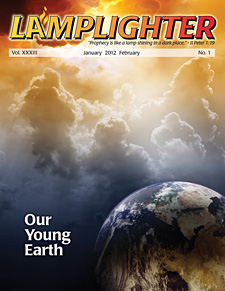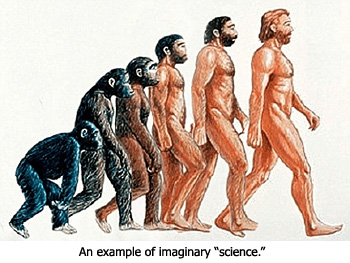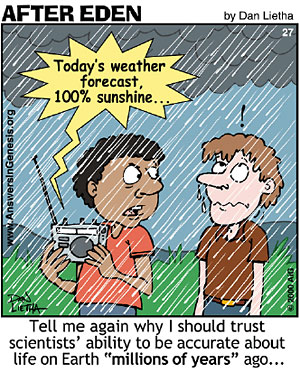Our Young Earth
It’s About Time: Why I Believe in a Young Earth
By James W. Hugg, PhD

(Editor’s Note: The first guest article related to our theme topic is authored by Dr. James Hugg, who is one of the trustees of Lamb & Lion Ministries. Dr. Hugg is a renowned research scientist who holds a doctorate in nuclear physics from Stanford University. He worked for Shell and British Petroleum before deciding to shift to the field of medicine where he became an expert on MRI technology. After serving as a research scientist for General Electric in Haifa, Israel, for several years, he moved back to California to become head of research for a medical technology company. He and his wife, Susan, and their two children live in the Simi Valley area of Los Angeles. They are members of the Shepherd of the Hills Church in Porter Ranch.)
For the first 18 centuries of Christianity, the Church almost universally believed in a literal Creation about 6,000 years ago1 and a global flood in the lifetime of Noah. In the early 19th Century, scientists began to develop an Old Earth Viewpoint to support the rise of Evolution Theory. If the Earth is only thousands of years young, as the Bible teaches, evolution of life in all its variety from nonliving chemicals is obviously impossible. Believers in Evolution feel comfortable with their current claim that the Earth is 4.54 billion years old.2 (I believe that is nowhere near enough time for random chance combinations of chemicals to produce even the simplest one-celled life form, but that discussion is beyond the scope of this article.)
Most of the Church accommodated the Old Earth Concept by “spiritualizing” the Genesis Creation account and developing theories of theistic evolution over billions of years.3 Those succumbing to this compromise approach usually also downgrade Noah’s worldwide flood to a local flood.4 In the past four decades, since the rise of Scientific Creation beginning in 1970 (when Henry Morris, PhD founded the Institute for Creation Research), a controversy has arisen between Young Earth Creationists (mostly Evangelical believers) and Old Earth Theistic Evolutionists (mostly mainline Protestants and Catholics).
Data Selection Bias: Self-Deception
All humans have a natural tendency for self-deception: we pay much more attention to observations that reinforce our viewpoints than to those that may contradict them. We readily dismiss contradictory data and accept confirmatory data with little scrutiny. By the very nature of this common human failure, the self-deceived are unaware that they have picked through a mountain of data to find the few observations that seem consistent with their preconceived notion of what is correct. But nowhere else have I encountered the extreme level of self-deception that exists among believers in Evolution.
Let me give you an example that I witnessed in my former career as a geophysicist for Shell and BP. You don’t need to understand the details of rock dating techniques to appreciate this most important point. When geologists study a rock formation that they expect, on the basis of Evolution Theory, to have a certain old age, they extract many samples from various locations in the formation and send them to several different labs that make the measurements of apparent age. After the results come back, they begin to weed out the samples that gave the “wrong” answer by assuming that the samples were contaminated. The “right” results that meet their expectations are presumed to be reliable. After this data selection process, the geologists are left with only the results that confirm their preconceived expectations.
I apologize if I have shocked you with the revelation that well-meaning, sincere scientists can be so biased in their selection of reportable data so that they can continue to support wholeheartedly the myth of Evolution Theory and proclaim it to be a fact. Any time that a large proportion of raw measurement data is being discarded and labeled “contaminated,” I suspect that the reported results will be strongly biased by the preconceived worldview.

After I studied the scientific evidence and rejected my former faith in Evolution,5 I bought a tee-shirt that declares: “Scientists should always state the opinion upon which their facts are based!” Believers in Old Earth Evolution Theory have selected a very small portion of the data that appears to support their expectations and they publish only the “correct” portion as “facts.” This self-deceptive habit of Evolutionists ignoring the vast majority of the data is one of the main reasons why I believe in Creation, a young Earth, and a worldwide flood.
We should not be too surprised that many of the observations discarded by believers in Evolution do, in fact, support Young Earth Creation.
God has revealed to us in the Bible His account of the origin of the universe and life. His Creation does testify to its supernatural origins.6 We can scientifically examine the Young Earth Creation model and test whether there are observations that support it.
Natural “Clocks” Estimate the Age of the Earth
Since no human being witnessed the creation of the Earth, we can only estimate its age by using various natural “clocks” and some assumptions. All of these “clocks” have common characteristics that we can illustrate by considering the simple example of the familiar hourglass.
An hourglass has two closed chambers connected by a narrow passage and a quantity of sand that gradually trickles from the top to the bottom chamber. We can tell how long the hourglass has been running if we measure the sand in both chambers, measure the trickle rate, assume the starting conditions (how much sand was in each chamber), assume that no sand was added or subtracted, and assume that the trickle rate has not changed.
Now, when we apply this hourglass analogy to methods for dating the age of the Earth, we will see that any of the assumptions may have been violated, rendering the apparent age estimate incorrect. This increases the importance of using all available methods and considering all observations.
Radiometric Dating
Let’s look at the main “clock” used by Evolutionists to estimate the age of the Earth: radiometric dating of granite or basalt. The term radiometric means that the natural process of radioactive decay7 is used to measure apparent age. Radioactivity is a natural process that changes a radioactive “parent” atom into a non-radioactive “daughter” atom. As a PhD in nuclear physics, I would love to explain all the intricate details of radiometric dating, but we don’t actually have to look very deep to find the problems that invalidate this favorite technique.
Although there are more than a half-dozen radiometric clocks in use, one example is enough to illustrate the method: the uranium-lead clock. Tiny crystals of zircon that are found in granite are assumed to naturally contain some uranium atoms when they are formed, but it is assumed that they start with no lead atoms. It is assumed that zircon crystals are impervious to addition or subtraction of uranium or lead, and it is assumed that the rate uranium changes into lead has always been constant. The hourglass analogy illustration shows uranium (red sand) in the top chamber and lead (green sand) in the bottom chamber. Half of the original uranium would have changed into lead in 4.5 billion years. If all the assumptions were true, then measuring precisely how many atoms of uranium and lead are in a zircon sample would yield a reliable estimate of the age of the sample.

Many samples are measured and the results are then sifted. If the apparent age is younger than expected (a “wrong” answer), then the sample result is labeled “contaminated.” Only those samples that give the expected result (a “right” answer) are presumed to be “uncontaminated” and reliable. You can see the circular reasoning and data-selection bias at work.
Known Problems with Radiometric Dating
Initial Conditions Assumption is Wrong: There are serious problems with the assumptions of initial conditions and constant change rate. Dating has been attempted on basalt rocks of known age formed from volcanic lava produced in recent history. If the dating method assumptions about initial conditions were correct, the apparent age of these newly formed rocks would be zero. But instead, examples from Hawaii, Mount St. Helens, and New Zealand have yielded apparent ages up to 3.5 million years.8 The radiometric method gives blatantly wrong answers on rocks of known age, so why should we believe the (highly selected) results reported for rocks of unknown age?
Radioactive Rate has Changed: Under most circumstances, radioactive change rates are constant and are not affected by the environment (heat, pressure, etc.). However, in a nuclear reactor the rates are greatly speeded up. We have found direct evidence of a natural reactor9 in Gabon, Africa. A “natural reactor” is a location where a heavy concentration of uranium exists, making the uranium-lead clock run very fast and thus giving the appearance of great age. If this natural reactor is later melted into magma and then becomes granite or basalt, then the apparent age of the rock formations would be billions of years, when, in fact, they are only thousands of years old. It is likely that such natural reactors were common and fed the magma released during the worldwide flood of Noah.10 Thus we would expect the appearance of great ages to be measured by radiometric methods.
A Bigger Problem: Many Clocks Support a Young Earth
Helium in zircon: During the change of each atom of uranium to an atom of lead, eight atoms of helium are produced. The rate at which helium leaks from zircon has been measured. There should be virtually zero helium left in zircon if the samples are truly billions of years old, yet the large amount of helium found in the samples indicates an age of only 6,000 (±2,000) years.11
Carbon 14 in Diamonds, Coal, and “Old” Rocks: Carbon 14 has a short 5,730 year half-life, so it is used to date archeological samples that are thousands of years old, but not anything expected to be millions or billions of years old. There should be virtually zero carbon 14 in anything older than 60,000 years, yet dating labs worldwide have known since the 1980’s that significant quantities of carbon 14 are routinely found in diamonds, coal, oil, and other organic compounds in rock strata that are supposed by Evolutionists to be millions of years old.12 This is further scientific evidence that the Earth is only thousands of years old.

DNA Mutations: Mitochondria are the power plants in every cell — plant or animal. Geneticists have studied the rate of mutation (genetic damage) in the DNA of human mitochrondria, which are passed only by the mother, and they have concluded that the mother of all humans — Eve — would have lived only 6,000 years ago.13 Accordingly, they think there must be something terribly wrong with their data. But I see it as further evidence of a young Earth.
Fossil DNA: Evolutionists insist that DNA cannot survive longer than 10,000 years, yet bacteria supposed to be 250 million years old have been revived with intact DNA,14 insects trapped in amber have yielded intact DNA strands despite their alleged age of millions of years,15 and dinosaurs — supposedly extinct for 65 million years — have been found with soft tissue and blood cells complete with largely intact DNA.16

Continent Erosion, Seafloor Mud, and Salty Oceans: Geologists have measured the erosion rate of continents and found that it would take only 50 million years to erode continents down to sea level.17 If the continents were truly 3.5 billion years old, they would be flat, just above sea level, and there would be no layers of rock strata. Continental erosion deposits 20 billion tons of mud (fine rock and dirt) on the ocean floor each year. If all the ocean floor sediment had been deposited this way, then it would have taken less than 12 million years. If the Earth were really 4.5 billion years old, the oceans would be choked with mud.18 If the oceans started as fresh water with zero salt, they would have reached their current level of saltiness in about 42 million years.19 All of these estimates, which don’t include the effects of Noah’s worldwide flood, argue that the Earth cannot be billions of years old.
Earth’s Magnetic Field is Rapidly Decaying: The Earth’s magnetic field has a total energy that is decaying rapidly at a rate for which the Earth could not be older than 20,000 years.20

Overpressured Petroleum Reservoirs: The Gulf of Mexico, for example, has deep deposits of petroleum (oil and gas) that are “over-pressured,” that is, at very much higher pressures than expected for their depth below the ocean and sediment. The 2010 BP Deepwater Horizon oil spill21 is a prime example. When I worked for BP and Shell in the 1980’s, we calculated (but could not publish) that the petroleum should have completely leaked out of the over-pressured reservoirs in less than 50,000 years. The integrity of the sediments will simply not hold that much pressure. In fact, there are spontaneous natural oil seeps throughout the Gulf of Mexico. The best explanation for the existence of these overpressured reservoirs requires a worldwide flood with very rapid deposition of plants and animals, rapidly covered by sediments, at a pressure and temperature that can produce petroleum in a few centuries.
Moon dust: Do you remember the fear that the first moon landing would be a disaster because the landing craft would sink in very deep moon dust? Scientists had calculated the rate at which moon dust is made by the impact of meteors on the lunar surface. Assuming that the moon is also 4.5 billion years old (the supposed age of the Earth), the dust should have been 20 feet thick. In fact, it is less than an inch thick, consistent with thousands, not billions of years. The Apollo 11 “Eagle” landing module did not sink in moon dust.
More Evidence for a Young Earth
I have selected only a few highlights of the scientific evidence that is mounting for a young Earth that is thousands of years old, not millions or billions. You may find many more resources at websites such as the Institute for Creation Research and Answers in Genesis.
Keep in mind that there are relatively few scientists brave enough to publish evidence for a young Earth and creation, so the volume of material is smaller than that published by the Evolutionists. Recall also that Evolutionists discard most raw data and bury it without publication because it does not confirm the Evolution Theory.
Jesus Taught A Young Earth
Jesus claimed to be “the truth” (John 14:6) and proclaimed that “the Scripture cannot be broken” (John 10:35). Jesus is identified as the Creator: “Through Him all things were made” (John 1:3). What then did He say about His Creation? There is much evidence that Jesus accepted Genesis 1-11 as literal history. He referred to Adam and Eve, Cain and Abel, Noah and the worldwide flood as history, not allegory.
There are three verses in which Jesus referred directly to recent Creation: “But at the beginning of creation God ‘made them male and female.'” (Mark 10:6); “Those will be days of distress unequaled from the beginning, when God created the world, until now…” (Mark 13:19); and “…the blood of all the prophets that has been shed since the beginning of the world from the blood of Abel to the blood of Zechariah…” (Luke 11:50-51). In all three cases He refers to humans existing from the beginning of creation, leaving no room for vast ages and slow evolution.22
Does It Really Matter What We Believe About The Age Of The Earth?
I claim it matters very much. I came to faith in Jesus because I became convinced that I could trust the truth of the Bible account of Creation and the worldwide flood. Genesis and Revelation are the “bookends” of the Bible. Jesus is the “Alpha and Omega, the Beginning and the End” (Revelation 1:8; 21:6; and 22:13). If we cannot believe God about Creation and Noah’s worldwide flood, then we cannot trust Him about anything else in His Word. How could we trust Him to resurrect us for eternal life if we think He deceived us with His account of six days of creation?
I think it matters a great deal what we believe about the age of the Earth. There are many scientific reasons to doubt the claims of atheistic Evolutionists that the Earth is billions of years old. And there are many scientific reasons to trust the biblical account that the Earth is actually only about 6,000 years young and that a devastating worldwide flood has greatly altered the face of our planet, giving us rock strata, fossils, continental breakup, coal and oil, mountains, and more.
I trust that your faith has been strengthened by considering the scientific reasons that were presented in this article for believing in the biblical account of creation and a young Earth. Believing the Bible is the most reasonable thing that an intelligent person can do.
Notes
1) Some scholars (not including me) believe there are significant gaps in the Genesis genealogies amounting to about 4,000 years, hence they estimate that the Earth is about 10,000 years old.
2) Wikipedia, “Age of the Earth,” http://en.wikipedia.org/wiki/Age_of_the_Earth.
3) David R. Reagan, “The Beginning and the Ending,” Lamplighter magazine, Sept-Oct 2011, pages 3-10.
4) Bruce Dorminey, “‘Noah’s Flood’ Not Rooted in Reality, After All?” National Geographic, February 6, 2009, http://news.nationalgeographic.com/news/2009/02/090206-smaller-noah-flood.html. See also: Wikipedia, “Black Sea Deluge Theory,” http://en.wikipedia.org/wiki/Black_Sea_ deluge_theory.
5) James W. Hugg, “How I Lost Faith in Evolution,” Lamplighter magazine, Sept-Oct 2011, pages 12-13.
6) Romans 1:20 (NIV): “For since the creation of the world, God’s invisible qualities — His eternal power and divine nature — have been clearly seen, being understood from what has been made, so that men are without excuse.”
7) Wikipedia, “Radioactive Decay,” http://en.wikipedia.org/wiki/Radioactive_decay. It is actually the nucleus of the atom, made up of protons and neutrons, that decays by radioactivity.
8) Mike Riddle, “Does Radiometric Dating Prove the Earth Is Old?” www.answersingenesis.org/articles/nab/does-radiometric-dating-prove.
9) Wikipedia, “Natural nuclear fission reactor,” http://en.wikipedia.org/wiki/Natural_reactor.
10) Genesis 7:11 (NKJV): “…on that day all the fountains of the great deep were broken up, and the windows of heaven were opened.”
11) D. R. Humphreys, “Young Helium Diffusion Age of Zircons Supports Accelerated Nuclear Decay,” Chapter 2 in Radioisotopes and the Age of the Earth, vol 2, ed. L Vardiman, et al (San Diego, CA: CR Press, 2005); http://www.icr.org/articles/view/3131/263.
12) J. Baumgardner, “Carbon Dating Undercuts Evolution’s Long Ages.” http://www.icr.org/articles/view/117/262.
13) A. Gibbons, “Calibrating the mitochondrial clock,” Science 279: 1998, pages 28-29. Mitochondria provide the chemical energy that powers our cells.
14) R. H. Vreeland, et al, “Isolation of a 250 million-year-old halotolerant bacterium from a primary salt crystal,” Nature 407: 2000, pages 897-900.
15) J. Cherfas, “Ancient DNA: Still busy after death,” Science 253: 1991, pages 1354-1356. R. J. Cano, et al, “Amplification and sequencing of DNA from a 120-135-million-year-old weevil,” Nature 363: 1993, pages 536-8.
16) M. Schweitzer, et al, “Soft-Tissue vessels and cellular preservation in Tyrannosaurus rex,” Science 207: 2005, pages 1952-1955.
17) B. Thomas, “Continents should have eroded long ago,” http://www.icr.org/article/continents-should-have-eroded-long.
18) W. W. Hay, et al, “Mass/age distribution and composition of sediments on the ocean floor and the global rate of sediment subduction,” Journal of Geophysical Research, 93(B12): 1988; pages 14,933- 14,940.
19) S. A. Austin & D. R. Humphreys, “The sea’s missing salt: a dilemma for evolutionists,” Proceedings of the Second International Conference on Creationism, vol. II, Creation Science Fellowship (1991), Pittsburgh, PA, pages 17-33.
20) D. R. Humphreys, “The Earth’s magnetic field is still losing energy,” Creation Research Society Quarterly, 39: 2002, pages 3-13.
21) Wikipedia, “Deepwater Horizon oil spill,” http://en.wikipedia.org/wiki/Deepwater_Horizon_oil_spill.
22) Dr. Terry Mortenson, “Jesus, evangelical scholars, and the age of the earth,” http://www.answersingenesis.org/articles/aid/v2/n1/Jesusand-the-age-of-earth.




